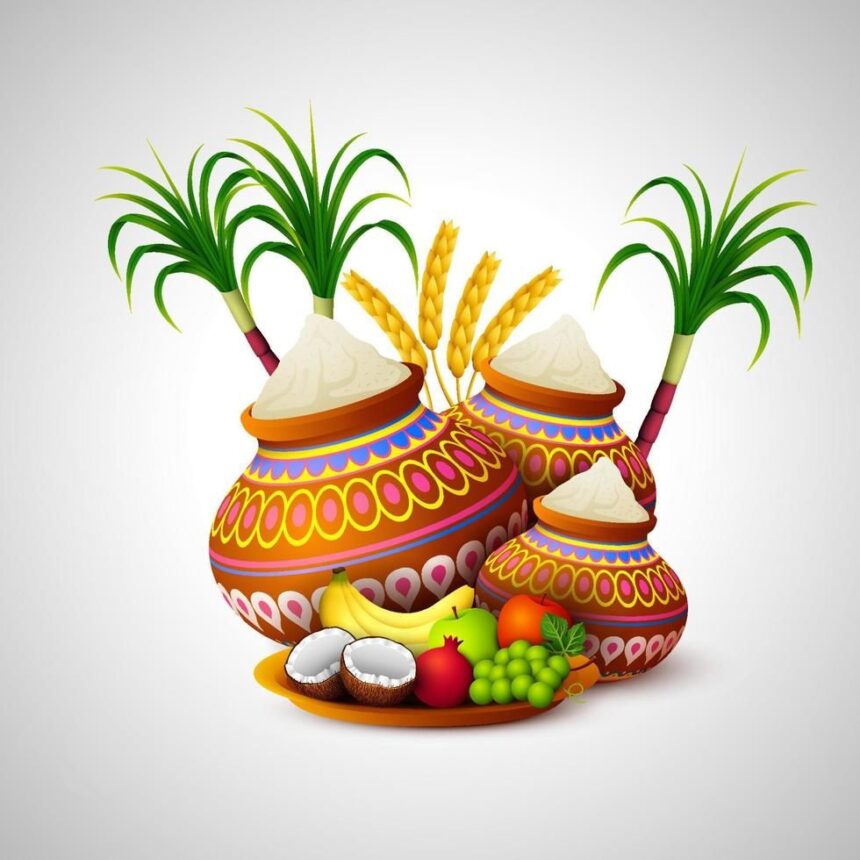🪔 Introduction: The Harvest of Hearts and Homes
When golden sunrays kiss the paddy fields, and freshly harvested rice fills the air with earthy aroma, it’s time to celebrate Pongal — one of the most beloved and spiritually enriching harvest festivals of South India.
- 📜 History of Pongal: A Festival Rooted in Agrarian Civilization
- 📅 Timeline of Pongal: Evolution Through the Ages
- 🌟 Top 10 Amazing Facts About Pongal
- ❓ Frequently Asked Questions (FAQs)
- 📌 When is Pongal celebrated?
- 📌 Is Pongal only for Hindus?
- 📌 Why is milk boiled during Pongal?
- 📌 What are the four days of Pongal?
- 📌 Where is Pongal celebrated outside India?
- 🙏 Significance of Pongal: More Than a Festival
- 🌞 1. Worship of the Sun God
- 🌾 2. Gratitude to Nature and Farmers
- 👪 3. Strengthening Family Bonds
- 🐄 4. Honoring Cattle
- ✨ 5. A Spirit of Renewal
- 🌍 Observance: How Pongal Is Celebrated
- 🍚 Cooking the Pongal
- 🎨 Kolam Designs
- 🎊 Music, Dance & Drama
- 🐂 Mattu Pongal Festivities
- 🧺 Kaanum Pongal Picnics
- 💬 Pongal Wishing Messages
- 📌 Important Cultural Points to Note
- 🧬 Importance of Pongal in Our Daily Lives
- 🌱 Teaches Respect for Nature
- 🙋 Empowers Cultural Identity
- 👨🌾 Recognizes the Invisible Labor
- 🫂 Encourages Community Living
- 🤝 Societal Impact of Pongal
- ✅ 1. Promotes Rural Tourism
- ✅ 2. Boosts Local Economy
- ✅ 3. Environmental Awareness
- ✅ 4. Inter-Religious Harmony
- 🪔 Conclusion: Pongal — A Festival That Nourishes the Body, Mind & Soul
Celebrated predominantly in Tamil Nadu, Pongal isn’t just a festival — it’s a season of gratitude, nature worship, family reunion, and cultural expression. It reflects the timeless Indian tradition of respecting nature, thanking the divine, and honoring hard work.
📜 History of Pongal: A Festival Rooted in Agrarian Civilization
The origins of Pongal trace back more than 1000 years, with deep roots in Dravidian culture and Sangam-era (200 BCE – 300 CE) Tamil literature. Historical texts mention Thai Niradal, an ancient festival observed by unmarried girls who prayed for prosperity and rain, abstaining from milk and meat during the Tamil month of Margazhi (December-January).
Over centuries, Pongal evolved into a grand harvest festival celebrated over four days, honoring the Sun God (Surya), cattle, and the land.
In Sanskrit, “Pongal” means “to boil over” — symbolizing overflowing abundance and prosperity. It also represents the boiling of the new harvest rice in milk — a key ritual in every Tamil household.
📅 Timeline of Pongal: Evolution Through the Ages
| Year/Period | Milestone |
|---|---|
| 200 BCE – 300 CE | Pongal mentioned in Sangam literature as a seasonal and religious observance |
| Chola Period | Kings conducted public Pongal festivities and temple rituals for prosperity |
| 1980s Onward | Pongal gains mainstream national visibility through TV, radio, and policy promotion |
| 2000s | Schools and colleges incorporate Pongal celebrations and competitions |
| Present Day | Celebrated globally by the Tamil diaspora in Sri Lanka, Malaysia, Singapore, UK, Canada, and the US |
🌟 Top 10 Amazing Facts About Pongal
Pongal spans four days: Bhogi, Thai Pongal, Mattu Pongal, and Kaanum Pongal.
It marks the beginning of the Tamil month ‘Thai’, which is considered auspicious for new ventures.
The dish ‘Sakkarai Pongal’ (sweet Pongal) is cooked in clay pots over wood fire, under sunlight.
The overflowing of the pot during the ritual is seen as a symbol of blessings and wealth.
Kolams (rangoli) drawn with rice flour invite prosperity and welcome birds and insects — an eco-friendly tradition.
On Mattu Pongal, cattle are bathed, decorated with garlands, and honored with reverence.
Pongal is celebrated by farmers, urban dwellers, and diaspora communities alike.
The festival is a non-religious cultural celebration, often uniting Hindus, Christians, and others in Tamil Nadu.
Pongal aligns with Makara Sankranti, celebrated in other Indian states.
It’s Tamil Nadu’s state festival and recognized as a public holiday.
❓ Frequently Asked Questions (FAQs)
📌 When is Pongal celebrated?
Pongal is celebrated every year from January 14 to January 17, coinciding with the sun’s transition into Capricorn (Makara).
📌 Is Pongal only for Hindus?
While rooted in Hindu agricultural traditions, Pongal is also a cultural festival observed by people of many faiths in Tamil Nadu.
📌 Why is milk boiled during Pongal?
Boiling milk with newly harvested rice in clay pots symbolizes prosperity, purity, and abundance. The overflowing signifies bountiful blessings.
📌 What are the four days of Pongal?
Bhogi Pongal – Honoring Lord Indra and discarding the old.
Thai Pongal – Dedicated to the Sun God (Surya).
Mattu Pongal – Celebrating and honoring cattle.
Kaanum Pongal – A day for family reunions and social visits.
📌 Where is Pongal celebrated outside India?
By Tamil communities in Sri Lanka, Malaysia, Singapore, Canada, South Africa, and the UK/USA.
🙏 Significance of Pongal: More Than a Festival
🌞 1. Worship of the Sun God
Pongal reveres Surya Dev, the eternal source of life and energy. It is believed that without the sun, no harvest could flourish.
🌾 2. Gratitude to Nature and Farmers
This festival celebrates Mother Earth, rain, cattle, and farmers — the unspoken heroes of our sustenance.
👪 3. Strengthening Family Bonds
The ritual of cooking together, sharing Pongal dishes, visiting relatives, and participating in kolam competitions revives the emotional warmth of family and community.
🐄 4. Honoring Cattle
Cows and bulls are garlanded and worshipped on Mattu Pongal. In rural households, they’re fed first before family members.
✨ 5. A Spirit of Renewal
Discarding old clothes and items, cleaning homes, and starting afresh aligns with spiritual cleansing and renewal.
🌍 Observance: How Pongal Is Celebrated
🍚 Cooking the Pongal
Families boil rice with milk and jaggery in earthen pots, chanting “Pongalo Pongal!” as the pot overflows.
🎨 Kolam Designs
Women and children draw intricate rice flour patterns outside homes each morning — inviting blessings.
🎊 Music, Dance & Drama
Traditional folk dances like Kummi and Kolattam, along with bullock cart races and village fairs, light up rural Pongal celebrations.
🐂 Mattu Pongal Festivities
Cattle are painted, adorned with bells and flowers, and sometimes taken on a festive procession.
🧺 Kaanum Pongal Picnics
Families visit riverbanks, parks, and relatives, spreading love and enjoying traditional Tamil meals together.
💬 Pongal Wishing Messages
🌞 “May your life overflow with joy like Pongal in a pot. Happy Pongal!”
🌾 “Wishing you prosperity, peace, and happiness this Pongal season!”
🐂 “Celebrate this harvest with love in your heart and gratitude in your soul. Happy Mattu Pongal!”
🎨 “Let your days be colorful like Kolams, and your life be as sweet as Sakkarai Pongal!”
🙏 “Let this Pongal bring sunshine of joy and harvest of success in your life!”
📌 Important Cultural Points to Note
Pongal is inseparable from Tamil identity, language, and pride.
It reinforces sustainable living and ecological awareness.
Children are taught values of gratitude, discipline, and tradition.
It’s a symbol of Indian agrarian respect, regardless of religion or region.
🧬 Importance of Pongal in Our Daily Lives
🌱 Teaches Respect for Nature
In a fast-paced digital world, Pongal reconnects us with seasons, soil, and sustainability.
🙋 Empowers Cultural Identity
For Tamil youth and diaspora, Pongal is a strong reminder of their cultural roots and responsibilities.
👨🌾 Recognizes the Invisible Labor
It reminds everyone — urban or rural — to appreciate the labor of farmers and the miracle of food on our plates.
🫂 Encourages Community Living
The festival promotes community participation, sharing, and unity, helping reduce loneliness and individualism.
🤝 Societal Impact of Pongal
✅ 1. Promotes Rural Tourism
During Pongal, villages open up to tourists, offering cultural insights, artisan sales, and rural experiences.
✅ 2. Boosts Local Economy
From earthen pot sellers to florists, sugarcane farmers to bullock cart drivers, many earn their livelihood during this season.
✅ 3. Environmental Awareness
Pongal promotes eco-friendly customs like natural colors, biodegradable items, and plant-based meals.
✅ 4. Inter-Religious Harmony
Pongal transcends religion, making it a symbol of secular celebration and mutual cultural respect.
🪔 Conclusion: Pongal — A Festival That Nourishes the Body, Mind & Soul
Pongal isn’t just about cooking sweet rice or decorating homes — it’s a deeply rooted expression of gratitude, joy, and identity. In an era of growing disconnection, Pongal reminds us of the values of thankfulness, family bonding, ecological consciousness, and simplicity.
Let us not only celebrate Pongal once a year, but embrace its message year-round: Give thanks. Stay grounded. Celebrate life.








